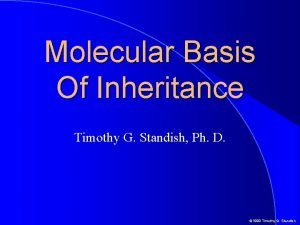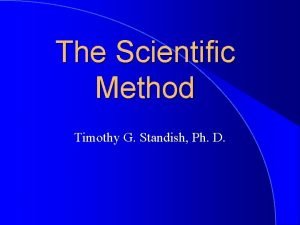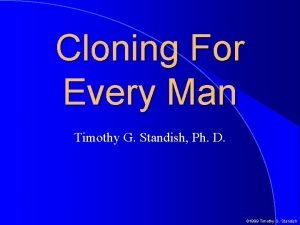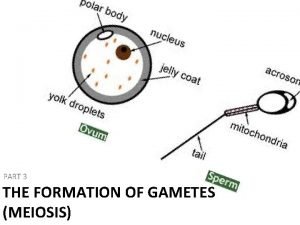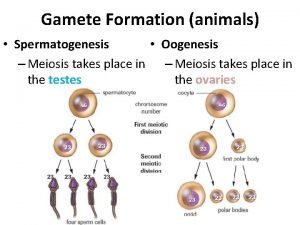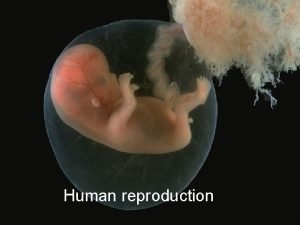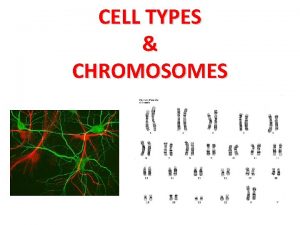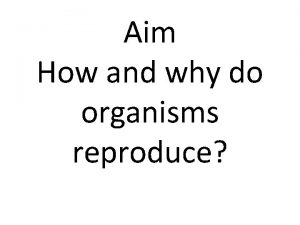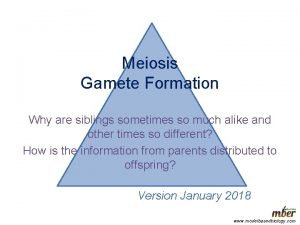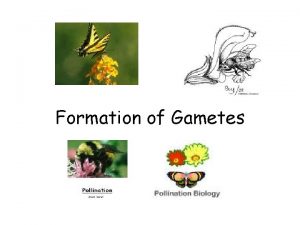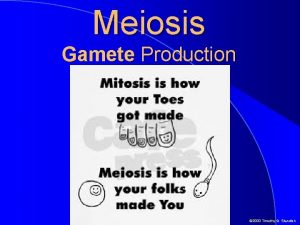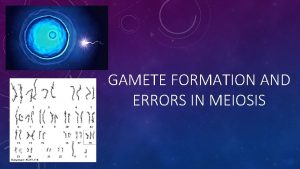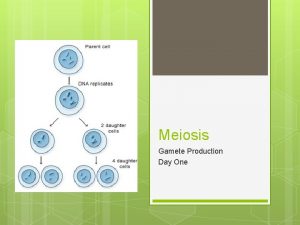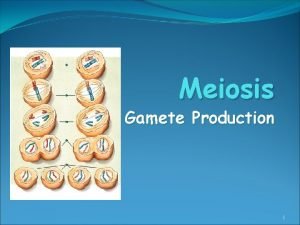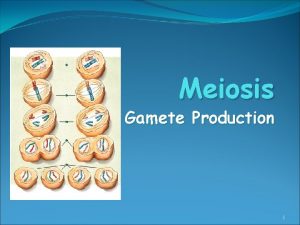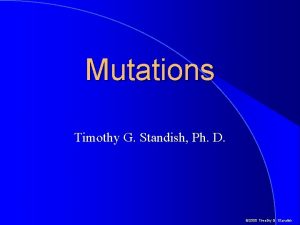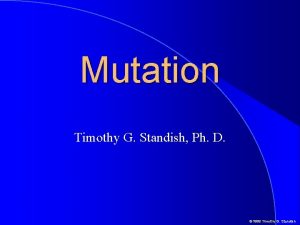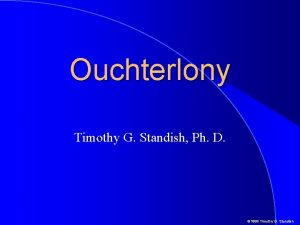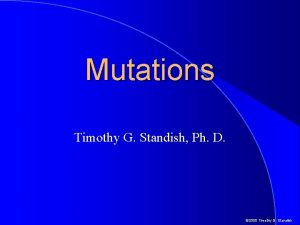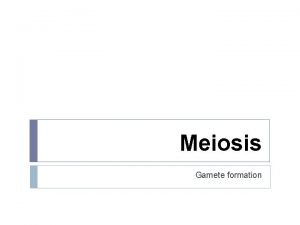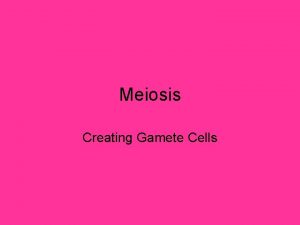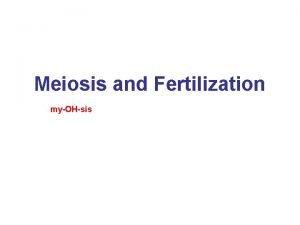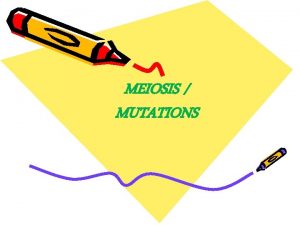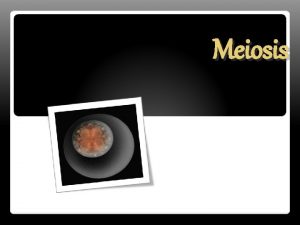Meiosis Gamete Production Timothy G Standish Ph D






















- Slides: 22

Meiosis Gamete Production Timothy G. Standish, Ph. D. © 2000 Timothy G. Standish

Chromosomes, Chromatids and Centromeres A packaged chromosome Chromatid Identical chromatid Chromosome arm Centromere Two identical chromosomes Replication Anaphase Chromosome arm © 2000 Timothy G. Standish

In The Beginning Two � Humans and many other complex multicelled organisms incorporate genetic recombination in their reproduction � Reproduction in which there is a re-mixing of the genetic material is called sexual reproduction � Two cells, a sperm and an egg, unite to form a zygote, the single cell from which the organism develops � Meiosis is the process of producing sperm and eggs (gametes) © 2000 Timothy G. Standish

Fertilization Results In A Diploid Zygote Egg 1 n Haploid nucleus Sperm 2 n Haploid nucleus © 2000 Timothy G. Standish

Fertilization Results In A Diploid Zygote Egg 1 n Haploid nucleus Sperm 2 n Haploid nucleus © 2000 Timothy G. Standish

Fertilization Results In A Diploid Zygote Egg 1 n Haploid nucleus Sperm 2 n © 2000 Timothy G. Standish

Fertilization Results In A Diploid Zygote Egg 1 n Haploid nucleus Sperm 2 n © 2000 Timothy G. Standish

From Zygote to Embryo Zygote 2 n 2 n © 2000 Timothy G. Standish

From Zygote to Embryo Cleavage © 2000 Timothy G. Standish

From Zygote to Embryo Cleavage © 2000 Timothy G. Standish

From Zygote to Embryo Cleavage © 2000 Timothy G. Standish

From Zygote to Embryo Cleavage © 2000 Timothy G. Standish

From Zygote to Embryo Morula © 2000 Timothy G. Standish

Gametes Are Haploid � Gametes must have half the genetic material of a normal cell � If the genetic material in the gametes was not halved, when they combined the zygote would have more genetic material than the parents � Meiosis is specialized cell division resulting in cells with half the genetic material of the parents � Gametes have exactly one set of chromosomes, this state is called haploid (1 n) � Regular cells have two sets of chromosomes, this state is called diploid (2 n) © 2000 Timothy G. Standish

Stages Of Meiosis � � � Meiosis resembles mitosis except that it is actually two divisions, not one These divisions are called Meiosis I and Meiosis II Meiosis I results in haploid cells with chromosomes made up of two chromotids Meiosis II is essentially mitosis on haploid cells Stages of meiosis resemble mitosis with two critical differences: the first in Prophase I and the second in Metaphase I © 2000 Timothy G. Standish

Stages Of Meiosis - Meiosis I � Prophase I - The beginning phase – DNA which was unraveled and spread all over the nucleus is condensed and packaged – Homologous chromosomes (each made of two identical chromatids) come together and form tetrads (4 chromatids) – Crossing over, in which chromatids within tetrads exchange genetic material, occurs � Metaphase I - Middle stage - Tetrads line up along the equator of the cell © 2000 Timothy G. Standish

Stages Of Meiosis - Meiosis I � � Anaphase I - One copy of each chromosome still composed of two chromatids moves to each pole of the cell Telophase I - End stage - New nuclear membranes are formed around the chromosomes and cytokinesis (cytoplasm division) occurs resulting in two haploid daughter cells © 2000 Timothy G. Standish

Stages Of Meiosis - Meiosis II � � Prophase II - Cells do not typically go interphase between Meiosis I and II, thus chromosomes are already condensed Metaphase II - Chromosomes line up at the equator of the two haploid cells produced in meiosis I Anaphase II - Chromosomes made up of two chromatids split to make chromosomes with one chromatid which migrate to the poles of the cells Telophase II - Cytokinesis and reformation of the nuclear membrane in haploid cells each with one set of chromosomes made of one chromatid © 2000 Timothy G. Standish

Mother cell Stages Of Meiosis: Meiosis I Interphase Prophase I: Condensing Chromosomes Prophase I: Tetrad formation/ crossing over Meiosis II Telophase I Metaphase I Anaphase I © 2000 Timothy G. Standish

Stages Of Meiosis: Meiosis II Telophase I Prophase II The products of meiosis are 4 haploid cells each with a unique set of chromosomes. Metaphase II The products of mitos are 2 diploid cells with identical chromosome Anaphase II Telophase II

Crossing Over Prophase I: Tetrad formation/ crossing over Because of crossing over, every gamete receives a unique set of genetic information. Telophase II Metaphase I Anaphase I Telophase I © 2000 Timothy G. Standish

© 2000 Timothy G. Standish
 Timothy g. standish
Timothy g. standish Timothy standish
Timothy standish Timothy standish
Timothy standish Timothy standish
Timothy standish When does crossing over occur
When does crossing over occur Step two
Step two Chromosomes form tetrads during
Chromosomes form tetrads during Pre post production
Pre post production Standish management
Standish management Standish group chaos report 2020
Standish group chaos report 2020 Skyward standish
Skyward standish Meiosis and mitosis
Meiosis and mitosis Picture of prophase 2
Picture of prophase 2 Concept mapping chapter 10 meiosis 1 and meiosis 2
Concept mapping chapter 10 meiosis 1 and meiosis 2 Concept mapping chapter 10 meiosis 1 and meiosis 2
Concept mapping chapter 10 meiosis 1 and meiosis 2 Difference between meiosis 1 and meiosis 2
Difference between meiosis 1 and meiosis 2 Meiosis vs mitosis anaphase
Meiosis vs mitosis anaphase Chapter 10 meiosis 1 and meiosis 2
Chapter 10 meiosis 1 and meiosis 2 Male and female gamete
Male and female gamete What is the difference between somatic and gamete cells
What is the difference between somatic and gamete cells Female gamete
Female gamete How many chromosomes
How many chromosomes What is gamete
What is gamete
